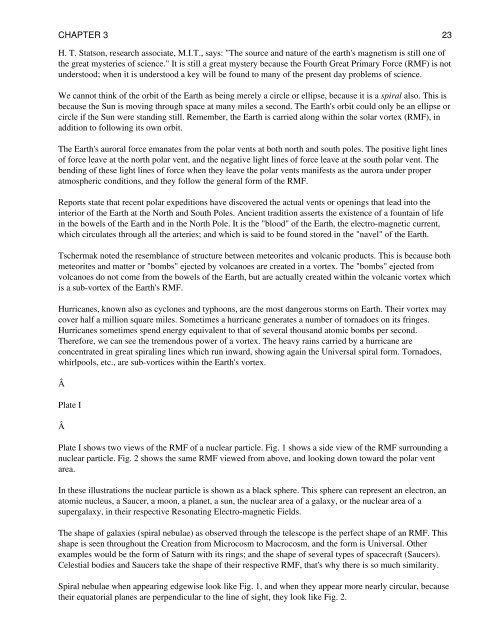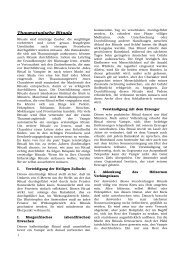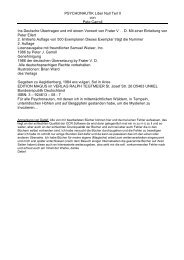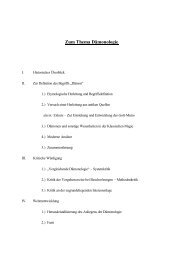CHAPTER 2 CHAPTER 3 CHAPTER 1 CHAPTER 2 CHAPTER 3 ...
CHAPTER 2 CHAPTER 3 CHAPTER 1 CHAPTER 2 CHAPTER 3 ...
CHAPTER 2 CHAPTER 3 CHAPTER 1 CHAPTER 2 CHAPTER 3 ...
You also want an ePaper? Increase the reach of your titles
YUMPU automatically turns print PDFs into web optimized ePapers that Google loves.
<strong>CHAPTER</strong> 3 23<br />
H. T. Statson, research associate, M.I.T., says: "The source and nature of the earth's magnetism is still one of<br />
the great mysteries of science." It is still a great mystery because the Fourth Great Primary Force (RMF) is not<br />
understood; when it is understood a key will be found to many of the present day problems of science.<br />
We cannot think of the orbit of the Earth as being merely a circle or ellipse, because it is a spiral also. This is<br />
because the Sun is moving through space at many miles a second. The Earth's orbit could only be an ellipse or<br />
circle if the Sun were standing still. Remember, the Earth is carried along within the solar vortex (RMF), in<br />
addition to following its own orbit.<br />
The Earth's auroral force emanates from the polar vents at both north and south poles. The positive light lines<br />
of force leave at the north polar vent, and the negative light lines of force leave at the south polar vent. The<br />
bending of these light lines of force when they leave the polar vents manifests as the aurora under proper<br />
atmospheric conditions, and they follow the general form of the RMF.<br />
Reports state that recent polar expeditions have discovered the actual vents or openings that lead into the<br />
interior of the Earth at the North and South Poles. Ancient tradition asserts the existence of a fountain of life<br />
in the bowels of the Earth and in the North Pole. It is the "blood" of the Earth, the electro-magnetic current,<br />
which circulates through all the arteries; and which is said to be found stored in the "navel" of the Earth.<br />
Tschermak noted the resemblance of structure between meteorites and volcanic products. This is because both<br />
meteorites and matter or "bombs" ejected by volcanoes are created in a vortex. The "bombs" ejected from<br />
volcanoes do not come from the bowels of the Earth, but are actually created within the volcanic vortex which<br />
is a sub-vortex of the Earth's RMF.<br />
Hurricanes, known also as cyclones and typhoons, are the most dangerous storms on Earth. Their vortex may<br />
cover half a million square miles. Sometimes a hurricane generates a number of tornadoes on its fringes.<br />
Hurricanes sometimes spend energy equivalent to that of several thousand atomic bombs per second.<br />
Therefore, we can see the tremendous power of a vortex. The heavy rains carried by a hurricane are<br />
concentrated in great spiraling lines which run inward, showing again the Universal spiral form. Tornadoes,<br />
whirlpools, etc., are sub-vortices within the Earth's vortex.<br />
Â<br />
Plate I<br />
Â<br />
Plate I shows two views of the RMF of a nuclear particle. Fig. 1 shows a side view of the RMF surrounding a<br />
nuclear particle. Fig. 2 shows the same RMF viewed from above, and looking down toward the polar vent<br />
area.<br />
In these illustrations the nuclear particle is shown as a black sphere. This sphere can represent an electron, an<br />
atomic nucleus, a Saucer, a moon, a planet, a sun, the nuclear area of a galaxy, or the nuclear area of a<br />
supergalaxy, in their respective Resonating Electro-magnetic Fields.<br />
The shape of galaxies (spiral nebulae) as observed through the telescope is the perfect shape of an RMF. This<br />
shape is seen throughout the Creation from Microcosm to Macrocosm, and the form is Universal. Other<br />
examples would be the form of Saturn with its rings; and the shape of several types of spacecraft (Saucers).<br />
Celestial bodies and Saucers take the shape of their respective RMF, that's why there is so much similarity.<br />
Spiral nebulae when appearing edgewise look like Fig. 1, and when they appear more nearly circular, because<br />
their equatorial planes are perpendicular to the line of sight, they look like Fig. 2.






